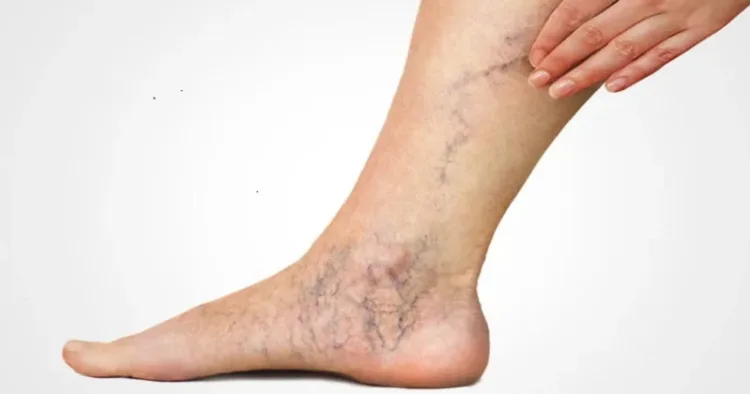Millions of individuals globally suffer from varicose veins, typified by enlarged, twisted veins frequently visible beneath the skin. While surgery and compression stockings are common conventional treatments, some people look for relief through alternative therapies like Ayurveda. The age-old Indian holistic medical system known as Ayurveda provides a special method that emphasises restoring equilibrium to bodily energies to enhance general health. But can varicose veins be adequately treated with it?
When vein valves weaken or malfunction, blood pools in the veins, causing the veins to bulge and become noticeably enlarged. This condition is known as varicose veins. Several factors, including heredity, extended standing or sitting, pregnancy, and obesity, influence their development. Pain, swelling, itching, and heaviness in the legs are common symptoms.
The Ayurvedic View of Varicose Veins
According to Ayurveda, exacerbated “Vata” and “Pitta” doshas (air and ether components) cause varicose veins (fire and water elements). Ayurvedic principles state that an imbalance in these doshas can weaken the veins and cause poor circulation, exacerbating varicose veins.
Varicose vein symptoms and indicators:
Varicose veins exhibit the following symptoms and indicators:
- Visible Veins: Usually appearing blue or dark purple, these bulging, twisted veins are seen just beneath the skin’s surface.
- Pain: Soreness or aching in the afflicted area, particularly after extended sitting or standing.
- Swelling: Edema, or swelling, in the ankles, feet, or legs, especially in the evening.
- Heaviness: The sensation of fullness or heaviness in the legs, particularly after extended standing.
- Itching: Skin rashes or itching in the impacted veins.
- Leg cramps or throbbing, especially at night, are called cramping.
- Skin Changes: Modifications to the skin’s texture, such as thinning, discolouration, or dryness over the afflicted veins.
Causes
When the veins’ valves weaken or stop working correctly, varicose veins form. Normally, these valves allow blood to travel upward and toward the heart by blocking reverse flow. Blood can pool or accumulate in the veins, causing them to expand and become varicose when these valves weaken or get broken. Varicose veins can occur due to several factors:
- Heredity: A family history of varicose veins is a significant contributing factor. You might have a higher chance of developing them if your parents or other close relatives have had them.
- Age: People are more likely to develop varicose veins as they age because their vein valves may deteriorate.
- Gender: Varicose veins are more common in women than in males. Birth control pill use and hormonal changes that occur throughout puberty, pregnancy, and menopause may raise the risk.
- Pregnancy: Pregnancy causes the body’s blood volume to grow while the blood flow from the legs to the pelvis decreases. Although the growing fetus is intended to benefit from this circulatory alteration, there may be an unwanted side consequence.
Approaches to Ayurvedic Treatment
Ayurvedic therapies for varicose veins aim to strengthen vein walls, enhance circulation, and lessen discomfort. The following are some typical Ayurvedic treatments and procedures:
- Herbal Treatments: To increase circulation and decrease inflammation, Ayurvedic doctors frequently recommend herbal formulations with components like Varuna (Crataeva nurvala), Guggulu (a resin), and Triphala (a combination of three fruits).
- Dietary Modifications: It is advised to follow a diet high in foods like leafy greens, fresh fruits, whole grains, and legumes that balance the Pitta and Vata doshas. Staying away from processed, hot, and salty foods is also advisable.
- Exercise and Yoga: It is helpful to perform modest yoga poses and circulation-boosting exercises like leg elevation and light stretching. Certain asanas or poses, such as the legs-up-the-wall pose (Virparita Karani), might enhance blood flow and lessen swelling.
- Lifestyle Modifications: To promote general vascular health, Ayurveda strongly emphasises lifestyle adjustments, such as avoiding extended periods of sitting or standing, elevating the legs when resting, and maintaining hydration.
Although Ayurvedic remedies present a potential holistic approach, it is imperative to exercise caution when utilising them:
- Discussion: Before beginning any new treatment plan, always get advice from a licensed Ayurvedic practitioner or healthcare professional, particularly if you are pregnant or already have health issues.
- Variability by Individual: Ayurvedic medicine tailors its therapies according to each patient’s unique constitution (Prakriti) and imbalance (vikriti). What suits one individual might not be appropriate for another.
- Combining Traditional Medical Practices: Ayurvedic therapy can enhance conventional medical methods. Notifying all healthcare professionals about the treatments being used is critical to guarantee coordinated care.
Ayurveda provides a comprehensive method of managing varicose veins by treating underlying imbalances and advancing general health. Even while it might enhance circulation and relieve symptoms, it should be combined with traditional medical care for a full course of treatment. In controlling varicose veins and improving general well-being, people may find that Ayurvedic therapies are helpful when used in conjunction with individualised treatment programs under the supervision of licensed professionals.



















Comments